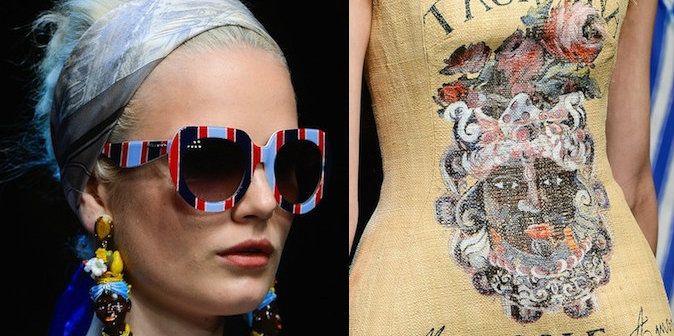Why We Shouldn't Pretend Dolce & Gabbana's Earrings Aren't Racist

What's a girl who loves fashion but hates the industry to do? Racism is fashion's constant companion, and the pair won't soon separate. It seems every season a major designer must be chastised for exploiting "exotic" prints and images or excluding models color. And every season these designers attempt to justify their bigoted missteps as byproducts of the artistry. There is, however, no explanation for why these earrings depicting the cartoonish heads of dark-skinned black women made it into Dolce & Gabbana's recent runway show.
To my Black American eyes, the women look like stereotypical mammies a la Aunt Jemima. To another Black woman, they looked like "dark-skinned Colombian women." In either case, the Dolce & Gabanna design team chopped off their heads and made them accessories. The heads were also printed on dresses and tops from the collection.
The figures appear to be a reconception of the "Blackamoor" jewelry and statues that are popularly collected in Europe. The characters are founded in racist tropes that originated during the colonial era.
After images of the earrings were posted to For Harriet's Facebook page, it seemed Black women couldn't come to the designer's defense fast enough. Outrage was characterized as "trivial" because the pieces were meant to be a "celebration" of African culture. The responses, though, disconcerting, aren't entirely unexpected. When faced with glaring examples of racial insensitivity, we often try to explain them away.
Domenico Dolce and Stefano Gabbana probably meant no harm when they chose to send the pieces down the runway. The problem is there's no way to view the work outside of their historical and social context. These earrings draw on the the long, Western tradition of the exploitation of Black women's bodies and likenesses.
There were no Black women modeling any of the more than 80 looks presented at the Dolce & Gabbana show. Our only appearance was hanging on the ears of pale models and adorning their bodies. We should be upset that our disembodied heads are welcome in spaces where our physical presences are not.
Are we so starved for cultural validation that we'll mistake any representation, no matter how damaging, for tribute? We are living, breathing beings not things to be collected as kitsch.
Fashion has an accountability problem, those who are excluded and erased are going to have to demand it. Dolce & Gabbana should not be allowed to profit off of perpetuating racist cultural myths. The willful colonization of Black culture in the fashion industry needs to be addressed. Our bodies are not trends. Our history is not free for consumption and misappropriation.
Kimberly Foster is the founder and editor of For Harriet. Email or Tweet her.

No comments: